When one goes to a new place, one takes a special interest in being pretentious and exploring the art and culture of that place, especially if it happens to be a touristy village, which is better known for its sandy beaches and cheap alcohol. That makes an exploration of the art and culture even more hipster. It was thus, on a too-hot-to-go-anywhere-else afternoon that I decided to visit the Mario Miranda Gallery in Calangute (one amongst 5 galleries dedicated to his work in Goa).
A posthumous recipient of the Padma Vibhushan, he is widely regarded as one of India’s greatest cartoonists, who was especially popular in the 1970s and ’80s, as his work appeared in several newspapers and magazines like Times of India and Femina, while he was also invited to different countries like Mauritius and Spain to sketch their local cultures.
Known for capturing the ethos of contemporary Goa and Bombay, Miranda’s art continues to remain popular. His 90th birth anniversary was celebrated with much fanfare in Goa last year with an exhibition of some of his original works entitled ‘A Pocketful of Chuckles’ and a free concert by his favourite musicians, even as opinion pieces in various newspapers and magazines commemorated the artist’s signature style and characters like Ms. Fonseca, the office secretary and Ms. Nimbupaani, the Bollywood actress.
there was something about his caricatures of women that made me uncomfortable.
The first time I was introduced to his work was when I visited the famous Café Mondegar at Colaba, known in equal measure for its delicious food and Miranda’s murals that were meant to capture both life in the city of Mumbai and the atmosphere of the café. I could not help but appreciate the vividness of the murals and the amazing attention to detail that made a glance at every corner of the café fascinating. But there was something about his caricatures of women that made me uncomfortable. I could not or rather did not try to put my finger on it, for I did not wish to ruin my experience of the vivaciousness of his art by coming to terms with its sexist nature.
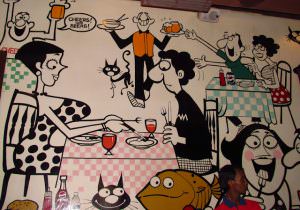
A mural by Miranda at Cafe Mondegar, Mumbai
Last week when I came across a Mario Miranda gallery stall at the Saturday night flea market at Arpora, I made up my mind to visit the nearby gallery at Calangute. The gallery turned out to be more of a shop that displays items of his that can be bought, from sketch prints to lampshades to clothing. However, visitors can sit at a coffee table with books by/on him and go through them undisturbed, and that was what I decided to do. I laughed at some of his funny observations of the world around, and admired his art work – be it the vibrant beauty of ‘Rainy Day in Mumbai’ that even a newcomer to the city can relate to, or the astute observation that comes across in sketches like ‘Togetherness’ that perfectly depicts the Mumbai local train at rush hour. But when a section of the book (Mario’s Best Cartoons Book I) dedicated to ‘Women and Relationships’ came along, that feeling of discomfort from Mondegar returned, amplified as I went through pages full of humour that reproduced sexist stereotypes.
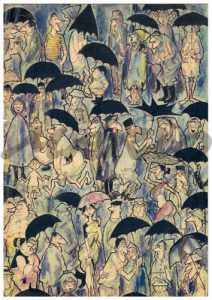
‘A Rainy Day in Mumbai’
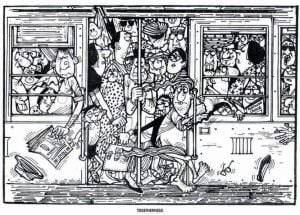
‘Togetherness’
Journalist Sunil Sethi wrote that Miranda prefered to call himself a social rather than a political cartoonist, describing himself as “a keen observer of people”. While the sections of the book on politics and prohibition were especially interesting because of the fascinating way in which documentation of his contemporary times served as a quirky reading of history for me, his observations of children, men at work in finance and politicians made me admire his observation skills as a self-professed social cartoonist.
Male characters were made fun of on the basis of their professions, quirky characteristics or inappropriate behaviour in public, largely drawing from the specific situations they were in. But the depiction of female characters seemed to be hand in glove with staple Whatsapp forwards I come across regularly on family groups – portraying women as looks obsessed, poking fun at women whose bodies do not conform to beauty norms, and reproducing the stereotype of the bullying, money burning, suspicious wife and the harassed, hard working husband.
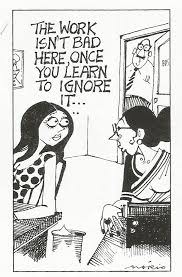
Ms. Fonseca giving ‘work advice’
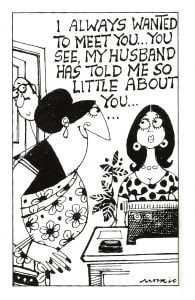
The conflict between the suspicious wife and the sexualised secretary
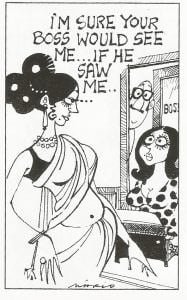
The oversexualized woman who only cares about her looks
A woman’s occupation does not really matter, for whether she is an office secretary or a homemaker, her lack of depth is unchanging. Moreover, while the woman’s body was oversexualized in almost all the sketches I saw, the same was not the case with the man, sketched in comfortable attire, with or without a paunch.
Through the iconic character of Ms. Fonseca, he also brings up the issue of sexual harassment at the work place, but I wonder if that stems from a conscious attempt to raise the issue, or whether it is just another aspect of Ms. Fonseca’s sexuality, which is the only thing that most sketches of her revolve around.
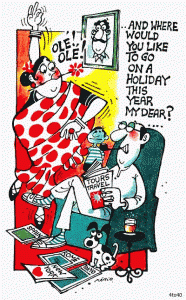
The overbearing wife and the overburdened husband
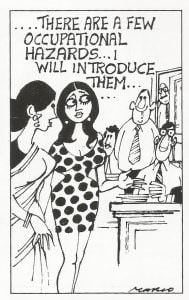
A commentary on sexual harassment?
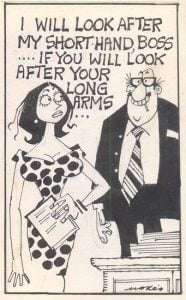
This is not an in-depth critical gendered reading of Miranda’s work by someone well-versed in the field of art or even in Miranda’s body of work, but simply what stayed in the mind of a lay 21-year old female student as she spent the day exploring the work of a renowned artist. I am not calling for a ban on Miranda’s artwork or even discarding his artistic ability as a cartoonist and painter.
A woman’s occupation does not really matter, for whether she is an office secretary or a homemaker, her lack of depth is unchanging.
What I am pointing to is the need for greater critical discourse around popular culture, especially around the work of those artists who have been labelled as ‘greats’ and are protected by all powerful shields of nostalgia. The most quoted cliché about art is that it reflects reality. Dissecting the reality of the life of women that is reflected through the works of Miranda is imperative, for countering the narratives around women that he has built is but a small part of the larger process of ensuring that popular culture, especially revered popular culture of the past, is read through the lens of gender, caste and class. Popular culture cannot remain a limited embodiment of the thinking of the privileged male but must thrive in diversity, and acts as a much needed source of comfort and laughter for all.
About the author(s)
Shrishti is a student of Media and Cultural Studies. Long rants with female friends help her channelize rage on the world around. Good food, pretentious poetry and cute canines provide her endless pleasure.





Mario Miranda was truly among one of the greatest artists India produced and his loss is still deeply felt in the Indian art community. BTW, interesting insight with the article, to each his own. As an artist, I could say that no one has actually been able to replace his void. His cartoons such as Family portrait – https://www.artzolo.com/painting/family-portrait-1971 and Fruit Seller –
https://www.artzolo.com/painting/fruit-seller are among my favorites.
Very Interesting Article, I like the way of presentation and I just love paintings and artworks. I like all the art works and paintings of Mario miranda. He was such an amazing artist and his loss is still felt in Art community.
You can also have a look for Family portrait – https://www.gallerist.in/love-paintings/family-love
Thanks for this balanced article. Often, we tend to view works of celebrated artistes in the way everyone else views them rather than through the filters of our own understanding coz the majority cannot be wrong. But, there do come in a few misgivings as you had when viewing Mario’s works. Mario was a product of his culture and as such represented it well, but is that the culture we want for ourselves in society today? I don’t think dialogue, introspection and questioning should ever stop even if the works had been done ages ago and the artist in question is long gone. Every work of art must answer to the questions and demands of the present time, at all times.
I completely agree. I had an image of Miranda in my head which was somewhat ruffled when I visited Panjim recently and studied his works in a bit more detail. I googled to see whether I and my friend (who was travelling with me) were alone in our opinion. Surprised to see only one article pointing this out.
You said it perfectly right. Who are we to say that one way of expressing art is better than the other? They are all unique and valuable in their own right! Are you looking forward to decorate your home and office walls with good art works? Just visit IndianArtZone from where you get a huge range of famous paintings from Indian Artists.